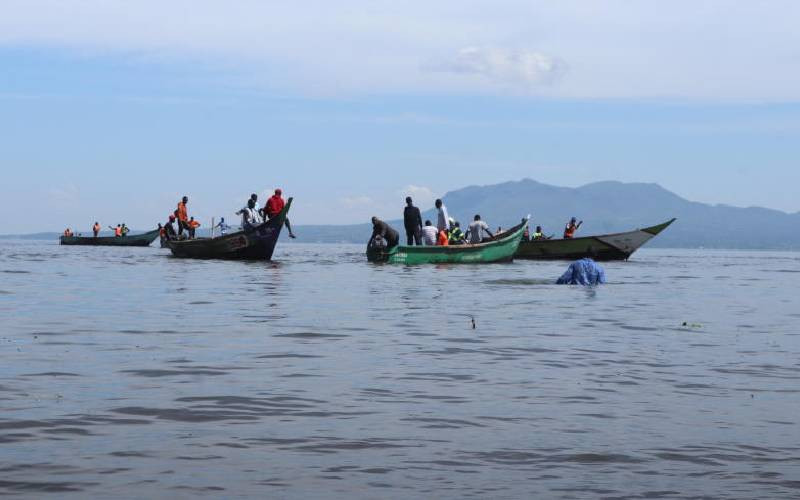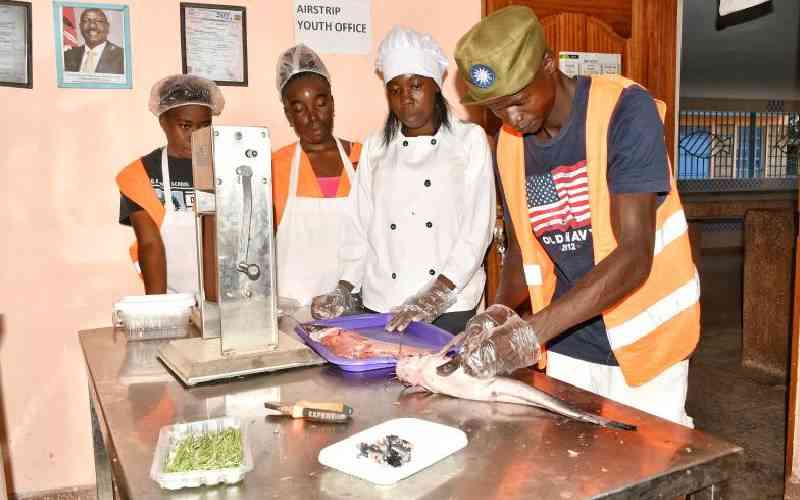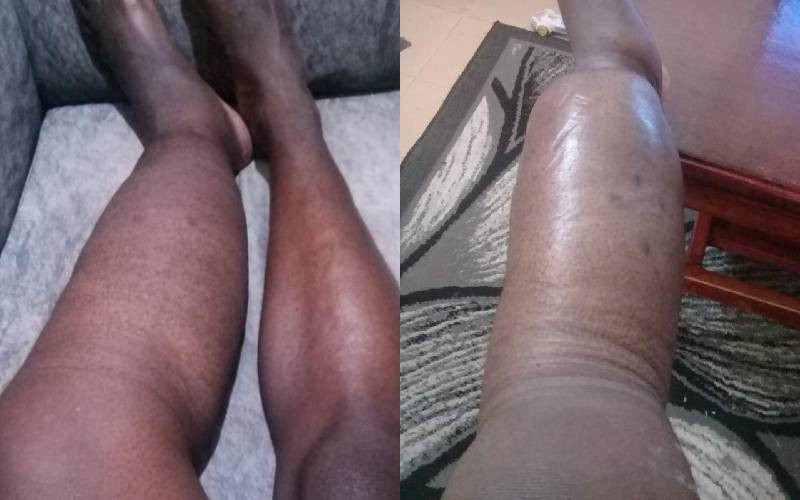Each day, between 150 and 180 traditional fishing boats leave Lwanda Kotieno beach in Siaya County to chase the latest shoal of Nile perch, Tilapia or dagaa in the expansive Lake Victoria.
Area Beach Management Unit (BMU) chairman Dickens Odhiambo says the fleets leave at three different times, depending on the type of fish they intend to catch.
“Those who want to catch Nile perch (mbuta) and Tilapia (ngege) leave at 3am and 12am respectively. Those chasing dagaa (omena) leave at 2pm. The time of return depends on the catch and the weather,” says Mr Otieno.
One would expect a beehive of activity when the fish come in the next day, but there is none. Instead, several refrigerated trucks queue by the beachfront, their owners, mostly Indians, sitting quietly in the vehicles while their representatives (middlemen) go ahead to meet the fleet.
Within minutes, all the fish is sold and packed in the waiting trucks, as money exchange hands.
Otieno says this was not the case a few years back. “By now, women fishmongers would jostle for bargains as they seek to buy fish to sell at the local markets, while a few middlemen would fight for the big fish destined for the city markets,” says Otieno.
On this day, he says, all the fish are sold before they even land. This is mostly due to the high demand occasioned by a new population that prefers the delicacy, depleted fish stock in the lake from overfishing and stringent fishing rules by the East African countries that share the lake resources.
The local community, whose traditional diet consists of fish are also forced to buy the commodity from the middlemen. Most of these fish were rejected by the main buyers, though they are also sold exorbitantly.
Some are forced to source their own fish from the dangerous lake if they want to meet their daily diet of the delicacy. When it is windy, they end up catching no fish.
High profits
Many brokers we talked to at the fish landing sites of Lwanda Kotieno, Mulukoba, Nyandiwa, Ogal, Soria and Wich Lum admitted they are not locals.
They would not even accept their photos to be taken. Some have come from as far as Nairobi and Mombasa, but they say the profits can be high since a plate of fish in a typical Nairobi restaurant sells for Sh800 for an average fish. Ironically, the price of the same plate of fish in Kisumu today goes for as much as Sh1,000.
“We buy the fish and mostly sell to Indians, who take the cargo for processing to Thika. We don’t know what happens thereafter. We also have hotel customers from Kisumu, Nakuru, Mombasa and Nairobi. Their preferred fish is the Nile Perch. We sell the remaining smaller tilapia to local businesses that ferry the fish to hotels and fishmongers,” says a broker, only known as Jarro.
Jarro says he can make as much as Sh50,000 on a good day. But the case is different for local fishermen who risk their lives and health to get the much-needed fish from the lake. “We sell one kilogramme of tilapia at Sh150 or Sh180. Nile Perch is more expensive (about Sh2,000 for a five-kilogramme fish), but they are getting scarce, so the bulk buyers make a lot more money.
"If there were cold storage facilities the local fishing population would benefit,” said George Omondi, a fisherman. Lack of such facilities means fishermen on Lake Victoria are forced to dispose of their catch promptly to avoid losses.
Stay informed. Subscribe to our newsletter
Augustine Wasonga, the CEO of ACE Africa, an NGO that works with fishing communities along Lake Victoria, says there is more than meets the eye in the fishing industry.
He cites the stalling of a European Union project that remains a white elephant despite getting full funding.
In the 2007 project, the Fishing Ministry entered a partnership with EU to build fish processing factories in five landing sites in Siaya County. The factories were to be fitted with cooling rooms and processors. The fish was then to be exported to the EU zone. Today, the projects are half complete.
“We read sabotage in the project. It is now seven years since the project was started. Some buildings were almost complete then abandoned at the last moment. This would have taken care of the middlemen problem, who continue to exploit the fishermen,” said Mr Wasonga when The Standard on Sunday visited some sites.
Generally, the price of Nile perch in Kisumu County has shot up by more than 48 per cent as demand continues to soar for the species. A kilo now sells at Sh270 compared to Sh140 a year ago.
Fish mongers at the fresh fish market attribute this rise in prices to the high demand for that particular type of fish in the East African region.
Commercial buyers
Fish vendors get the fish from various beaches along Lake Victoria such as Usenge, Lwanda K’Otieno, Mbita with Kisumu’s Dunga Beach also producing a small quantity of the same. Most of the catch is sold to commercial buyers from Nairobi and neigbouring Uganda.
David Oduor, a fish vendor at the Fresh Fish Market at the main Kisumu bus terminus claimed that a lot of Nile perch goes to Uganda, then sold back to local markets when the prices are high.
Mr Oduor said they used to sell to fish processing companies such as the East African Sea Food and FP2000 AT Sh140 or Sh160, but this has since changed due to demand.
At the famous Lwang’ni beach hotels, a plate of tilapia fish, which is the preferred delicacy goes for between Sh800 to Sh1,000. The owners say they are forced to buy the fish from brokers since fishermen would not sell to them.
The few women fishmongers who dare visit the lakeside for fish say they are sometimes forced to dish out sexual favours to the fishermen.
“What women go through to get fish is deplorable. Some have ended up being infected with HIV to get that fish. If only we could have our own fish processing plants in this region, maybe things would be better,” said Susan Akello, a hotel owner at Lwang’ni Beach in Kisumu.
 The Standard Group Plc is a
multi-media organization with investments in media platforms spanning newspaper
print operations, television, radio broadcasting, digital and online services. The
Standard Group is recognized as a leading multi-media house in Kenya with a key
influence in matters of national and international interest.
The Standard Group Plc is a
multi-media organization with investments in media platforms spanning newspaper
print operations, television, radio broadcasting, digital and online services. The
Standard Group is recognized as a leading multi-media house in Kenya with a key
influence in matters of national and international interest.
 The Standard Group Plc is a
multi-media organization with investments in media platforms spanning newspaper
print operations, television, radio broadcasting, digital and online services. The
Standard Group is recognized as a leading multi-media house in Kenya with a key
influence in matters of national and international interest.
The Standard Group Plc is a
multi-media organization with investments in media platforms spanning newspaper
print operations, television, radio broadcasting, digital and online services. The
Standard Group is recognized as a leading multi-media house in Kenya with a key
influence in matters of national and international interest.








